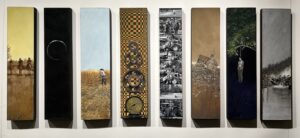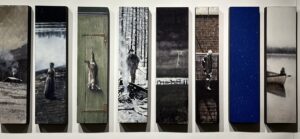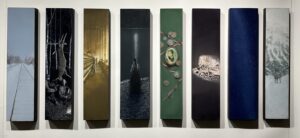The poor thing, he’s seen so much. Death sprawls across the field, bodies lying next to one another like pieces in a jigsaw puzzle. How do you walk through a field like that? Some of the men clutch photos of their wives and children; the dead hold the living. If this was supposed to make a man out of him, why do they call him a drummer boy?
That boy is Jeremiah Smith, the fictional character at the center of William Ciccariello’s Lower 48, a series of paintings on view at Rice Polak Gallery in Provincetown. The 48 paintings, each one chilling and indelible on its own, work together to form something like a novel. Arranged in six chapters, with eight panels to a chapter, the paintings follow Jeremiah from being orphaned in mid-19th-century America to serving in the Civil War to an adulthood where this dreadful past seems always to be an unwelcome visitor. Each panel haunts the next, the way yesterday leaves its trace upon today.
In Chapter 2, staring out at a lake, it all flashes before him. This should be a peaceful image, a boy standing on a diving board fully clothed in capris and a white tee, his silhouette slim and sturdy, the water inviting contemplation or play or a reprieve. But this image is flanked by images of war: garrisons decimated, rifles abandoned, death made more ubiquitous than oxygen. You can taste the gunpowder.

“The painting of the boy on the diving board,” says Ciccariello, “is suggesting that he’s at this point of vulnerability. He’s witnessed some terrible things. He’s on the edge of something, literally and psychologically. Violence surrounds him.”
Unlike a novel, with paragraph after paragraph of detail after detail, Lower 48 doesn’t provide a narrative but suggests one. It empowers the viewer to fill in the gaps, to be co-author of this story, not just looking but imagining.

“It is to be read the way we remember distant relatives and their lives; obscure, unsure, far away, out of focus,” Ciccariello writes in his description of the work. “These are the pictures that tell us as much of the story that will ever be known.”
Those pictures are varied. In Chapter 1, a dead bunny, its hind leg tied with twine, hangs from a nail. A few panels later, a hooded man hangs by his neck from a metal chain; the painting is based on a photograph of the public execution of the conspirators in President Lincoln’s assassination. A woman stands by a lake; a man stands in the woods. Their surroundings weigh on them. They’re alive, but they’re ghostly. We can feel them fade: this is what it’s like to be an orphan, to have not the memory of your parents’ presence but only the miasma of their loss.

Each chapter contains one astrological image and one still life. In Chapter 2’s still life, a steak knife is stabbed into a cantaloupe. “It’s in keeping with the brutality of the other panels,” says Ciccariello. Steel makes its way into something sweet. Violence finds its way from the battlefield and into the home.
Ciccariello was born in 1954 and grew up on Long Island. His grandmother was an artist who had studied with Hans Hofmann; though she died before Ciccariello was born, her paintings filled his childhood home. He studied at the School of the Museum of Fine Arts in Boston, has worked as a painter since, and lives in Jamaica Plain.
Joy, Ciccariello admits, is scarce in Lower 48. Death and destruction thread the needle here. If the work feels bleak, that’s because the period of American history it chronicles is bleak. The Civil War, replete with weapons created by the Industrial Revolution, unleashed slaughter on a scale the world had never seen before. Over 750,000 people died. “They died in heaps,” Jill Lepore writes in These Truths. “They were buried in pits.”

During that time, 11 states in our country went morally bankrupt. The Confederacy’s vice president, Alexander Stephens, gave a speech in Savannah, Ga. in which he made this plain as day: “Our new government is founded upon the idea,” he said, “that slavery is natural and moral. This, our new government, is the first, in the history of the world, based upon this truth.” The Confederacy was founded at a time when pro-slavery fanaticism and white supremacy were at a fever pitch. “It rested upon the foundational belief that a minority governs a majority,” Lepore writes. “American slavery had turned hearts to stone. It had made eyes blind.”
The Civil War was also the first war to be photographed. Death didn’t just happen — it was on display. Many of Ciccariello’s panels are painted from photographer Matthew Brady’s documentation of the war. “If [Brady] has not brought bodies and laid them in our dooryards and along the streets,” the New York Times wrote at the time, “he has done something very like it.”

Other panels are similarly painted from archival images: a still from Ingmar Bergman’s 1957 The Seventh Seal, the film reel of Gregory Peck chucking his glasses off and then shooting the mad dog in To Kill a Mockingbird, a Winslow Homer painting. Lower 48 is a master class in intertextuality, Jeremiah Smith’s story coming into view through the montaging of other stories. Ciccariello also notes that his process was informed by reading Wallace Stegner and Cormac McCarthy.
By Chapter 6, Jeremiah Smith is nearing death. The images that have so far made up his life, rectangular and severe, become circular and kaleidoscopic. There is a frenzy here, a supercut of the decades that came before: hunted animals and emaciation and gravestones and human corpses and mournful cries and grim reapers. Yet, amid this rubble, Smith emerges as someone who’s much more than a product of his country’s violent history. His story is deeply felt and not easily forgotten, existing in the interplay between painting and viewer and lingering long after.

Intertextuality
The event: William Ciccariello’s painting series Lower 48
The time: Through Wednesday, July 31
The place: Rice Polak Gallery, 430 Commercial St., Provincetown
The cost: Free
